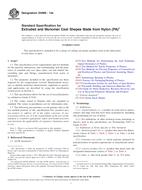We need your consent to use the individual data so that you can see information about your interests, among other things. Click "OK" to give your consent.
ASTM C1339-02(2012)
Standard Test Method for Flowability and Bearing Area of Chemical-Resistant Polymer Machinery Grouts
STANDARD published on 1.8.2012
The information about the standard:
Designation standards: ASTM C1339-02(2012)
Note: WITHDRAWN
Publication date standards: 1.8.2012
SKU: NS-10755
The number of pages: 5
Approximate weight : 15 g (0.03 lbs)
Country: American technical standard
Category: Technical standards ASTM
The category - similar standards:
Manufacturing processes in the rubber and plastics industries
Annotation of standard text ASTM C1339-02(2012) :
Keywords:
bearing area, chemical-resistant polymer machinery grout, flowability, surface contact, ICS Number Code 83.020 (Manufacturing processes in the rubber and plastics industries)
Additional information
| Significance and Use | ||
|
5.1 Chemical-resistant polymer machinery grouts are used to provide precision support for machinery or equipment. 5.2 The machinery or equipment or support bases or plates, or combination thereof, are positioned to the precise elevation and location required. The bases or plates are typically placed on prepared foundations and supported on temporary shims or support bolts (jack screws). Forms are installed to contain the flowable grout. The grout is poured around the perimeter in such a manner as to allow the grout to flow around and under the equipment base or plates. The grout subsequently hardens to provide a strong rigid support layer capable of withstanding the stresses transferred by the equipment to the foundation. 5.3 In addition to the required physical properties of the grout, the flow and bearing area achieved are important considerations for effective grout installation. The two characteristics measured by this test method are flow and bearing area. 5.4 The flow test simulates typical application conditions for a flowable polymer machinery grout. It may be used to evaluate the suitability of a particular grout for a specific application, to compare the flowability and bearing area of two or more grouts, or to evaluate the effects of formulation changes, temperature, mixing techniques, or other factors on flowability. 5.5 The estimated amount of upper grout surface contact in percent can be used to compare two or more grouts or show the effects of temperature, formulation changes, or other factors on bearing area. Because of the limited accuracy in estimating the percent of contact, a limited set of results is suggested (see 1.1 This test method covers the measure of flowability of chemical-resistant polymer machinery grouts as evaluated in a 2-in. (5-cm) or 1-in. (2.5-cm) pour thickness. The test method provides for the assessment of upper surface plate contact area (bearing area). These grouts will typically be two- or three-component formulations that may be used for installations where grout thickness will range from 1 to 6 in. (2.5 to 15 cm) underneath the base or plates being grouted. 1.2 The values stated in inch-pound units are to be regarded as standard. The values given in parentheses are mathematical conversions to SI units that are provided for information only and are not considered standard. 1.3 This standard does not purport to address all of the safety concerns, if any, associated with its use. It is the responsibility of the user of this standard to establish appropriate safety and health practices and determine the applicability of regulatory limitations prior to use. |
||
| 2. Referenced Documents | ||
|
Similar standards:
Historical
1.9.2014
Historical
1.4.2009
Historical
1.7.2014
Historical
1.5.2011
Historical
1.8.2010
Historical
1.9.2009
We recommend:
Technical standards updating
Do you want to make sure you use only the valid technical standards?
We can offer you a solution which will provide you a monthly overview concerning the updating of standards which you use.
Would you like to know more? Look at this page.



 ASTM D5900-14a
ASTM D5900-14a ASTM D5946-09
ASTM D5946-09 ASTM D5989-14a
ASTM D5989-14a ASTM D6085-97(2011)..
ASTM D6085-97(2011).. ASTM D6247-10
ASTM D6247-10 ASTM D6265-09
ASTM D6265-09
 Cookies
Cookies
